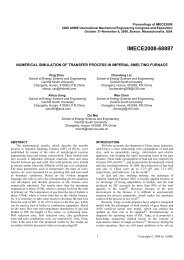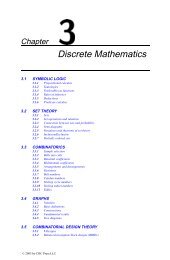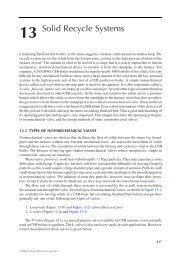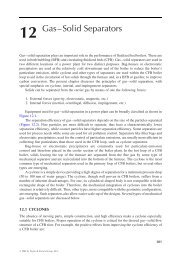Chapter 4: Geometry
Chapter 4: Geometry
Chapter 4: Geometry
Create successful ePaper yourself
Turn your PDF publications into a flip-book with our unique Google optimized e-Paper software.
4.1.4.1 Relations between Cartesian and polar coordinates<br />
Consider a system of polar coordinates and a system of Cartesian coordinates with<br />
the same origin. Assume that the initial ray of the polar coordinate system coincides<br />
with the positive Ü-axis, and that the ray ¼ Æ coincides with the positive Ý-axis.<br />
Then the polar coordinates ´Öµ with Ö¼ and the Cartesian coordinates ´Ü ݵ of<br />
the same point are related as follows (Ü and Ý are assumed positive when using the<br />
ØÒ<br />
½ formula):<br />
´<br />
Ü Ö Ó× <br />
Ý Ö ×Ò <br />
Ô<br />
<br />
Ö Ü¾ · Ý ¾ <br />
Ý ØÒ ½ Ü <br />
×Ò <br />
Ó× <br />
Ý<br />
Ô<br />
ܾ · Ý ¾ <br />
Ü<br />
Ô<br />
ܾ · Ý ¾ <br />
4.1.5 HOMOGENEOUS COORDINATES IN THE PLANE<br />
A triple of real numbers ´Ü Ý Øµ, with Ø ¼, is a set of homogeneous coordinates<br />
for the point È with Cartesian coordinates ´ÜØ Ýص. Thus the same point has many<br />
sets of homogeneous coordinates: ´Ü Ý Øµ and ´Ü ¼ Ý ¼ Ø ¼ µ represent the same<br />
point if and only if there is some real number « such that Ü ¼ «Ü Ý ¼ «Ý Þ ¼ «Þ.<br />
When we think of the same triple of numbers as the Cartesian coordinates of<br />
a point in three-dimensional space (page 345), we write it as ´Ü Ý Øµ instead of<br />
´Ü Ý Øµ. The connection between the point in space with Cartesian coordinates<br />
´Ü Ý Øµ and the point in the plane with homogeneous coordinates ´Ü Ý Øµ becomes<br />
apparent when we consider the plane Ø ½ in space, with Cartesian coordinates<br />
given by the rst two coordinates Ü Ý (Figure 4.4). The point ´Ü Ý Øµ in space can<br />
be connected to the origin by a line Ä that intersects the plane Ø ½in the point with<br />
Cartesian coordinates ´ÜØ Ýص or homogeneous coordinates ´Ü Ý Øµ.<br />
Homogeneous coordinates are useful for several reasons. One of the most important<br />
is that they allow one to unify all symmetries of the plane (as well as other<br />
transformations) under a single umbrella. All of these transformations can be regarded<br />
as linear maps in the space of triples ´Ü Ý Øµ, and so can be expressed in<br />
terms of matrix multiplications (see page 306).<br />
If we consider triples ´Ü Ý Øµ such that at least one of Ü Ý Ø is non-zero,<br />
we can name not only the points in the plane but also points “at in nity”. Thus,<br />
´Ü Ý ¼µrepresents the point at in nity in the direction of the ray emanating from<br />
the origin going through the point ´Ü ݵ.<br />
4.1.6 OBLIQUE COORDINATES IN THE PLANE<br />
The following generalization of Cartesian coordinates is sometimes useful. Consider<br />
two axes (graduated lines), intersecting at the origin but not necessarily perpendicularly.<br />
Let the angle between them be . In this system of oblique coordinates, a<br />
point È is given by two real numbers indicating the positions of the projections from<br />
the point to each axis, in the direction of the other axis (see Figure 4.5). The rst<br />
axis (Ü-axis) is generally drawn horizontally. The case ¼ Æ yields a Cartesian<br />
coordinate system.<br />
© 2003 by CRC Press LLC










